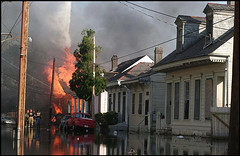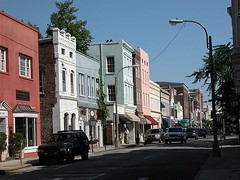Leadership lessons from Charleston, SC
The New Orleans Times-Picayune has an excellent article about Charleston, South Carolina, and its approach to reconstruction after the disaster of Hurricane Hugo. In particular, the article "A SISTER CITY FLOURISHES--After Hurricane Hugo ravaged Charleston, the historic city demonstrated that a city can prosper if it takes care to keep its charm as it rebuilds," discusses how Mayor Joseph Riley, perhaps the U.S. mayor most committed to historic preservation and urban design, stepped up and made sure that Charleston not only preserved its historic character, but improved as a city.
While it's true that both cities experienced disaster, the big difference is that Charleston didn't have the terrible flooding and long-term standing high water experienced by New Orleans. But even so, if the public officials were committed to maintaining the city's core competitive advantage of history and architeccture, they could have worked through this. Instead Mayor Nagin wants to build HOPEVI like housing developments.
 New Orleans, LA. Evacuations continued as residents of this ravaged city are being found over a week after Katrina battered the Gulf Coast. Numerous fires broke out across the city sending fire crews and national guardsmen scrambling. An early morning fire in the city's east side. Photo: Michael Robinson-Chavez, The Washington Post.
New Orleans, LA. Evacuations continued as residents of this ravaged city are being found over a week after Katrina battered the Gulf Coast. Numerous fires broke out across the city sending fire crews and national guardsmen scrambling. An early morning fire in the city's east side. Photo: Michael Robinson-Chavez, The Washington Post.
Clearly, leadership is so key. It really demonstrates that who gets elected, and their abilities, world-view, and vision matters. There is probably no mayor in the U.S. more committed to urban design and preservation than Mayor Riley. While there are, sadly to say, probably worse mayors than Ray Nagin, and worse governors than Kathleen Blanco, there probably aren't many.
Similarly, wrt Maryland, I was talking with someone last night, and we were talking about the likely ouster of the current CEO of WMATA, Richard White. We speculated about Dan Tangherlini replacing him, but that Maryland state appointees would never allow it, as she said "You have a governor that hates transit..." (Every jurisdiction has to have board members vote in favor or a board action is vetoed.) Given that the WMATA board is made up of all politicos, sound transit planning and action in the region is often held hostage to ideology. Toll roads anyone?
It's why I write about Maryland politics, and to some extent Virginia politics, more than I ever expected I would. In some respects Maryland matters more because Washington abuts the State of Maryland directly, while it is only connected via bridges to Virginia, but still...
From the article:
But Rosenblum's house wasn't the only mess he had on his hands after the hurricane. There was also Charleston's treasury of fine old buildings, many of which had taken a devastating hit. As a member of the city's Board of Architectural Review, Rosenblum had a mandate to protect those buildings and see that they were properly restored. A city agency that controls the appearance of buildings in the historic district -- an agency roughly comparable to New Orleans' Vieux Carre Commission -- the board took a tough stand from the beginning. "We decided that in the long run, the best thing to do was to do it right," he said.
And they did. They insisted that a metal roof be replaced by a metal roof, that a facade maintain its integrity and that nothing that could be fixed would be torn down. "We have buildings all over town right now that owners wanted to tear down," Rosenblum said. "If you say 'no' enough, eventually somebody comes along and has a use for it and saves it. "If the building has good bones, fix it. If you start ripping things down, you're gong to lose the city." Losing the city is what Rosenblum fears for New Orleans...
 King Street,Charleston. Photo copyright by Art Hill.
King Street,Charleston. Photo copyright by Art Hill.
Slim and slight at 62, with graying hair and white eyebrows, Riley won an unprecedented eighth term in office recently. Beloved locally and respected nationwide, he is known in some circles as the best argument in America against term limits. "In the immediate aftermath, he convinced people -- and that's a strong word, convinced -- that their local elected officials could get them out of dutch and back on the road," said Steve Mullins, managing editor of the Charleston Post and Courier, the city's daily paper. "And by golly, that's what happened. "He knew how to get help and get it into people's hands. FEMA was too late and too cautious and too slow. So people didn't look to FEMA; they looked to Joe Riley. If he says it, it's going to be true.
"He was phenomenal." With an unflappable temperament, a lot of late nights, a firm sense of organization and an effective media presence, Riley helped his city come back in grand style. Charleston today is a prosperous and vibrant place -- lively, swanky, immaculate. The antebellum houses, with their Palladian windows and long porches, are pristine, many without a flake of paint in sight. The old gardens are clipped and orderly with handsome brick walkways and well-bred hedges. Elegant church spires pierce a diminutive skyline. And King Street downtown -- narrow and intimate and architecturally vivacious -- is jammed with shops and shoppers.
In most parts of town, it would be hard to see any evidence that there was ever a hair out of place, never mind a disaster that rattled this city within an inch of its life. By nearly every measure, the city is better than ever, stronger than it was before the storm. The population has grown by about a quarter. Tourism is up, shipping is up, construction is up and unemployment is down to 4.7 percent. Retail trade has doubled and the sale price of an average home has shot up, outpacing the national boom. The hotels are packed, the restaurants are chic and the tourists, to a notable degree, are well-mannered and well-groomed.
Today, Riley offers the same prognosis for New Orleans.
Index Keywords: historic-preservation; leadership; elected-officials



0 Comments:
Post a Comment
<< Home